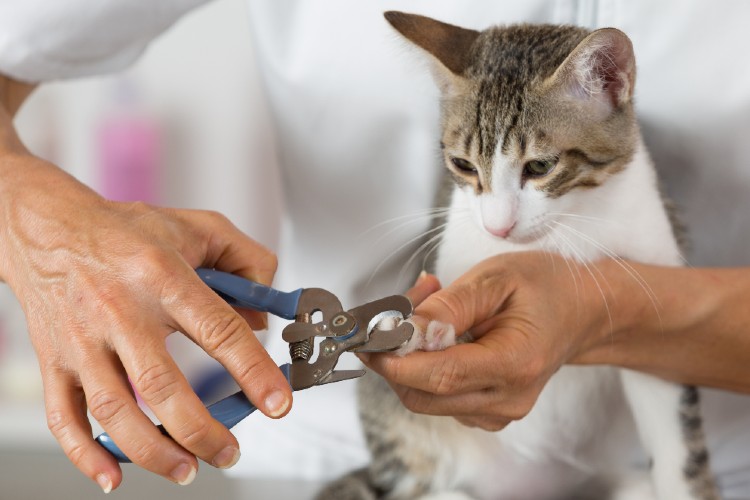Thinking about trimming your cat’s nails? Here’s what you need to know about when to consider trimming your kitty’s claws and how to go about it if you need to.
Why Do I Need to Trim My Cat’s Nails?
Cats’ claws grow continuously and will require trimming on a regular basis. Cats typically learn to tolerate the procedure without much fuss, especially if it is started when they are young kittens. If your cat is not a kitten, don’t despair, you can work with your cat to help them feel comfortable with claw trimming!
The most crucial aspect of claw trimming for cats is to always remember to go slow, be positive, and make the experience as pleasant as possible for your pet. One negative incident can leave your cat fearful and resenting their pedicure.1
Strategies for Claw Trimming
Start young: To teach a cat to be comfortable with claw trimming, the best strategy is to start young. I recommend that all new kitten owners begin trimming their cat’s claws as soon as possible. Just touching and holding the feet can go a long way to teaching cats to accept claw trimming.2
Get comfortable: Putting your pet into a comfortable position is also imperative. I prefer to lie the cat down on its back on my lap where the feet point upwards. You can use pillows or towels on either side of the cat to hold them up and make them feel secure.
Praise: Lastly, do not forget the importance of positive reinforcement. This is perhaps the best strategy of all, as it teaches the cat that claw cutting results in petting and treats!
Getting Started
Before beginning, make sure to gather all the necessary supplies. You’ll need good, sharp nail trimmers, cat treats, and a calm, comfortable place to trim.
Sitting in a chair or on the couch and then lying the cat upside down on my lap works best. You may need to simply lie the cat down a few times without trimming to get them used to the position. Always pet the cat and treats when they lie still.
When your cat is comfortable lying on their back, begin holding and rubbing the paws. Again, you may need to do this step multiple times over the course of days or weeks until the cat is comfortable. Always offer positive reinforcement when the cat accepts the touching.3
The next step is getting your cat comfortable with nail extension. Start by grasping each toe and pushing the nail into an extended position by gently pressing on the top of the toe. This is a foreign feeling to the cat, and they may resist at first. Repeat this procedure daily until the cat is accepting on all four feet.4
The last step before beginning actual claw trimming is to get your cat familiar with the sound of their nails being cut. One way to do this is to hold the cat’s paw and extend the nail while a friend or family member uses the trimmers to cut a piece of spaghetti near you. Though this will not prepare the cat for the sensation, cats are often startled by sudden noises, so this exercise can go a long way to familiarize your cat with the procedure.5
Time to Trim
Don’t rush. The proceeding steps may happen all in one day for some cats or they may take weeks. Allow your cat time to become comfortable with what you are trying to do. It’s always better to go slow rather than to hurry and potentially give the cat a bad experience. Cats that are rushed in the beginning may always fight claw trimming.
Extend the claw and gently snip off the curved, sharp end of the nail. For clear colored claws, you will be able to see the “quick” inside the nail. For darker claws you should only aim to clip off the tip to ensure you are not cutting too close. Cutting into the “quick” will hurt the cat and possibly make them bleed, so it’s always better to leave more claw than to hurt the cat.6
I prefer small, cat–sized, scissor–style clippers for cats; you may want to ask your veterinarian if they recommend a specific brand or style. Regardless, always make sure your clippers are sharp and clean before trimming.
Once you’ve trimmed the first claw, immediately let go of the cat’s paw and begin your positive reinforcement of treats and petting. If the cat is happy and not struggling, go on to the next claw. However, if they are uncomfortable or struggling in any way, let them go and start again tomorrow. It may require several short sessions to get all their nails trimmed.
When to Trim
Claws will need to be trimmed about once every two weeks for most adult cats.7 There are exceptions to this on both ends, as some cats may need trimming more frequently and some may go longer between trims. Provide a scratching post for your cat to use between nail trims.
At first, it may take a week of short daily sessions to trim all your cat’s claws successfully. Be patient and with time, your cat will become comfortable and eventually allow you to do them all at once.
Article Sources
Pets Digest uses only high-quality sources, including peer-reviewed studies, to support the facts within our articles. Read our editorial process to learn more about how we fact-check and keep our content accurate, reliable, and trustworthy.
- The Humane Society of the United States. How to trim your cat’s nails. Humanesociety.org. Accessed August 5, 2022.
- Wisconsin Humane Society. Cat nail trimming 101. Wihumane.org. Accessed August 5, 2022.
- American Society for the Prevention of Cruelty to Animals. Cat grooming tips. Aspca.org. Accessed August 5, 2022.
- American Society for the Prevention of Cruelty to Animals. Cat grooming tips. Aspca.org. Accessed August 5, 2022.
- American Society for the Prevention of Cruelty to Animals. Cat grooming tips. Aspca.org. Accessed August 5, 2022.
- Barnette C. How to trim a cat’s nails. Vcahospitals.com. Accessed August 5, 2022.
- American Society for the Prevention of Cruelty to Animals. Cat grooming tips. Aspca.org. Accessed August 5, 2022.


